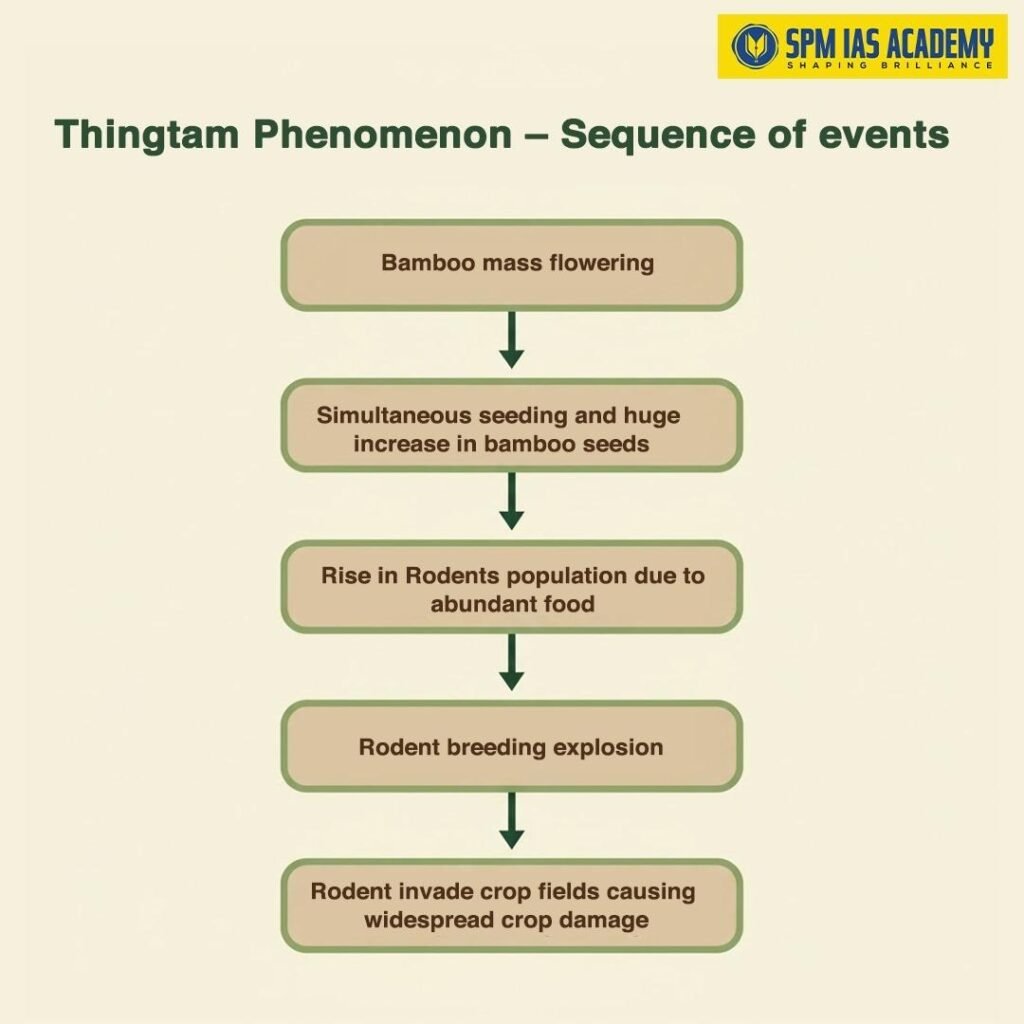This article discusses the unique Thingtam Phenomenon in Mizoram. It highlights its history, causes and consequences on our ecology, agrarian economy and livelihoods of the farmers in Mizoram. This is relevant for Both Prelims (GS- 1) and Mains (General Studies – 3 (Environment, Ecology, Disaster) of USPC CSE, APSC CCE and Other State Public Service Commission Exams.
Why In News?
- Recently, rodent infestation has struck 15 villages in Mizoram’s Mamit district due to mass bamboo flowering. It has posed a threat to harvests, raising famine like the Thingtam phenomenon.
- Consequently, it has led to destruction of paddy fields of around 4000 families in 122 villages in Mizoram.
What Does the Thingtam Phenomenon Mean?
- Primarily, Thingtam refers to a cyclical phenomenon where large-scale flowering of the bamboo species Bambusa tulda occurs. It generally occurs roughly once every 48 years in Mizoram and other states of Northeast India.
- While it may appear to be climate-driven, the Thingtam phenomenon is actually part of the bamboo’s natural ecological cycle.

- Mizoram is facing a severe rodent outbreak across its 11 districts, leading to large-scale destruction of paddy and other crops. The phenomenon, triggered by the mass flowering of the ‘Bambusa tulda’ bamboo species, known locally as ‘Thingtam’, has caused a sudden surge in rat populations.
- As a consequence, nearly 4,000 households across 130 villages affected and over 1,737 hectares of paddy already destroyed.
- The Mizoram government has requested the State Disaster Management and Rehabilitation Department to declare the situation a “state disaster”.
- In fact, this ecological crisis resembles previous bamboo flowering events in Mizoram, especially the Thingtam of 1977 and the Mautam of 2007–08, which both triggered famine-like conditions across the state.
The Status of Rodent Outbreak In Mizoram?
- The Agriculture and Farmers’ Welfare Minister reported widespread destruction of paddy, maize, sugarcane, cowpea, chili, sesame, and ginger crops.
- This has affected 11 districts in Mizoram including Aizawl, Champhai, and Serchhip having highest damages.
- Rodent control operations such as mass poisoning campaigns and distribution of rodenticides are being conducted.
- In the preliminary assessments, it has been found that more than 25% of Mizoram’s cultivated paddy area has suffered losses.
- Despite the launch of a new crop insurance policy, affected farmers may not be eligible for compensation since the policy became operational only after the damage began.
- The state government has requested urgent central assistance and disaster classification to facilitate relief funds.
Thingtam Phenomenon – Sequence of Events

Historical Overview of the Thingtam Phenomenon
- Earlier Instances During the British Period:
- Government records indicate that similar famines struck the Mizo Hills during the British era, specifically in 1862 and 1911, following bamboo flowering events.
- In Independent India:
- Mautam Famine (1958–59):
- In 1958–59, mass flowering of bamboo (Melocanna baccifera) led to an explosion in the rodent population.
- The rats destroyed standing crops and rice granaries, causing a severe famine known locally as ‘Mautam’ with loss of hundreds of lives.
- In that famine situation, New Delhi’s negligence created deep resentment among the Mizo people triggering the Mizo insurgency in 1967, led by Laldenga.
- Mautam Famine (1958–59):
- Cyclical Nature of Thingtam:
- As per local belief, Thingtam occurs once every 48 years.
- The last such crisis surfaced in 1977, roughly 48 years ago from the current expected cycle.
- Post 2000:
- In 2008, Mizoram again faced famine-like conditions due to rodent infestations following bamboo flowering and in 2022, farmlands in 9 districts were affected by rodent attacks.
- In 2022, roden attack affected farmlands in nine districts.
What are the Factors causing Rodent-Driven Crop Losses?
- Firstly, the mass flowering bamboo species locally called ‘rawthing’ triggers rat infestations.
- Heavy monsoon rains aggravated the crisis causing rampant weed growth in jhum fields.
- Favourable Breeding Conditions for rodents due to warm and humid climate.
- Climate change is disrupting traditional flowering cycles and lengthening the breeding periods of rats.
- In addition, poor Rodent Management Systems in remote hilly areas due to lack of awareness.
What Impacts Thingtam Phenomenon may have on Agriculture and Food Security?
- Firstly, it can threaten the stability of Mizoram’s economy as Mizoram has an agriculture based economy with about 70% of its population dependent on farming.
- Rats affected paddy crops significantly. Furthermore, it affected other crops such as maize, sugarcane, cow pea, ginger, chili, pumpkin, sesame, and cucumber in some areas.
- Around 4,000 rural households face total loss of annual income . and fields of 800 farmers have been affected.
- The recent rodent attack has affected around 800 jhum farmers. As Mizoram depends heavily on subsistence agriculture, crop destruction can lead to grain shortages threatening food security in the state.
- Rat infestations raise potential for zoonotic diseases and contamination of food stocks.
What are the measures and strategies available?
To address the recurring threat of rodent-induced crop losses, a combination of immediate, institutional, and long-term strategies can be implemented to mitigate damage and build resilience.
- Immediate Measures:
- The Agriculture Department supplied rodenticides such as bromadiolone and zinc phosphide to district agriculture officers.
- Village-level committees and village council leaders are conducting coordinated extermination campaigns.
- Teams of agriculture officials will guide farmers.
- Traditional methods like slingshots and local rodent traps such as ‘vaithang’, ‘mangkhawng’ and ‘thangchep’ are also used by farmers to kill rats.
- Institutional and Policy Responses
- Declaration of State Disaster under the Disaster Management Act, 2005 to mobilize funds.
- Crop Insurance Reform to include ecological events like Thingtam.
- Early Warning Systems to strengthen meteorological and ecological monitoring.
- Scientific & Long-Term Approaches
- Conducting ecological Research on bamboo flowering and rodent cycles by leading institutions like agricultural universities and ICAR institutes.
- Promote Alternative Cropping with emphasis on crops less susceptible to rodent attacks.
- Community Storage Units like Rat-proof granaries and improved food storage systems can be promoted.
- Bio-Control Methods and efforts for conservation of natural predators (owls, snakes, civets).
Conclusion:
To sum up, the 2025 Thingtam phenomenon in Mizoram highlights the interdependence between ecology, livelihoods, and disaster governance in Northeast India. Although a natural ecological cycle, its consequences become disastrous when aggravated by insufficient preparedness and limited risk protection mechanisms. Lessons from the 1958 Mautam and 1977 Thingtam crises must be considered in present policy formulation with emphasis on scientific monitoring, community engagement, and adaptive local planning. As M.S. Swaminathan (Father of India’s Green Revolution) said, “The future of our agriculture depends not merely on increasing production but on ensuring ecological sustainability”, recognition of the outbreak as a state disaster will be a timely step to ensure swift relief measures and safeguard the agrarian economy of Mizoram.
Sources:
- https://timesofindia.indiatimes.com/city/guwahati/73-families-in-mizorams-lunglei-resist-mass-poisoning-of-rodents/articleshow/124311918.cms
- https://assamtribune.com/north-east/mizoram-seeks-state-disaster-status-as-rats-destroy-paddy-crops-1594305
It is a cyclical bamboo flowering event (every ~48 years) in Mizoram that causes massive rodent outbreaks.
Because rodent infestations linked to Thingtam have destroyed crops in over 120 villages across 11 districts.
The mass flowering of Bambusa tulda (locally called ‘rawthing’) causes this phenomenon.
It causes widespread crop loss, food insecurity, and threatens the livelihoods of thousands of farming families.
The state is conducting rodent control drives, supplying rodenticides, and seeking central disaster assistance.












